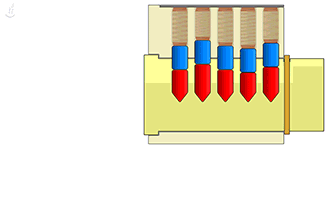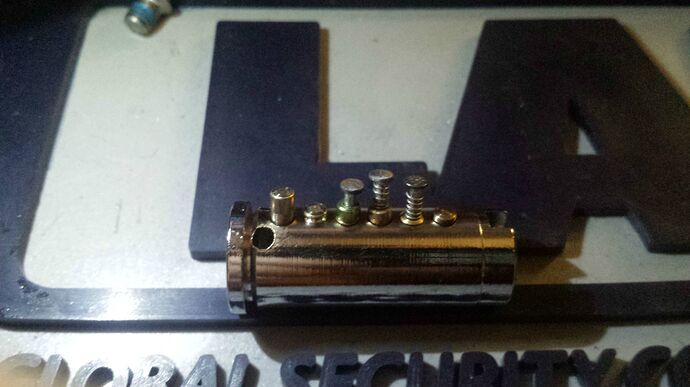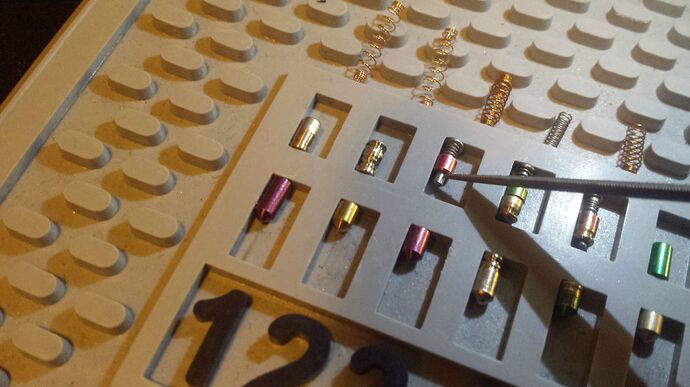I figured I’d throw this up here too, as follow-up on the lock workshop where we talked a bit about security pins. I also posted this up on Keypicking.com, one of the major longstanding lock security & lockpicking forums, as a first post (been a lurker for ages… figured it was time).
Quick recap—

Drivers are the blue pins, which with the aid of a spring pushes down driver pin, onto the key pin (in red), which comprises that pin stack. When picking we need to apply tension to the plug of the lock, while manipulating the pin stacks, negotiating each stack among its others to clear each stack by locking the driver pin against the shear line between the plug and the housing (using the torque on the plug to hold captured drivers in place).
More more example GIFs see Deviant Ollam’s awesome resources: The Open Organisation Of Lockpickers
First configuration
Anyway, the idea is creating a pin-in-pin design for the driver pins, in order to have two separate mechanical parts that interact, but not always in the same way inside the top chamber of the lock. This introduces different types of feedback on the same pin-stack, at different stages of its picking. If you push up on the corresponding key pin a first time you will likely first make contact with the inner pin (the nail), and thus only one spring (the main spring for that chamber). However, if you make contact with the outer jacket of the nail you end up just pushing up freely… if it’s not bound up already, or, you might put pressure on both, which should feel pretty odd. :D
This first setup is seen in chamber #3.
So that got me thinking into introducing a second, tiny little spring (actually 1/2 of a cheap US lock’s cam pin spring) onto the nail itself, in between (1) the main spring, and the nailhead as a buffer, and (2) the outer jacket pin.
In this second pic all three pin-pin-pins (#3, #4, #5) have this new spring.
In this second configuration, picking should — in theory — further or differently frustrate manipulation and clearance of the outer jacket (which is most likely to bind before the nail does itself of course). When picking the outer jacket pin a picker would be working against two springs: the main spring and the outer jacket pin’s spring on the nail. Negotiating this should be hard, and could lead to compressing the entire stack up too far, likely resetting the entire pin stack, and/or other pin stacks. To this end I also turned the outer jacket pins into security pins (mushroom-ish and serrations).
If you clear the outer pin successfully, you may then likely fall into a deep false set that is the remaining tip of the nail. (Should be noted too that the deepest false set this lock (pinned almost as pictured above) would give should be when a picker just has any number of the pin-in-pin stacks left to go… if indeed the lock picks that way… I think it does from my attempts.) Since I put 3 of these suckers into the lock (I ended up keeping one of Flywheel’s original spring-less configuration) it should provide plenty of opportunities to undo picking progress. :D
I can’t pick this damn thing.
Did this with a table-mounted vise that held a 20+yo German dremel (which just seems be doin fine), 2 Lockwood brass standard top-pins, and 1 Lockwood polished steel top pin (which took a lot longer to drill through), mounting the pins in the dremel and holding the drill bit manually using a visegrip against the spinning pin.
Flywheel, the chap who came up with the initial idea did up a pretty YT video showing how he made his:

